Detailed Business Environment Analysis Report: Sainsbury's Operations
VerifiedAdded on 2020/02/05
|13
|4364
|78
Report
AI Summary
This report provides a detailed analysis of the business environment, focusing on the operations of Sainsbury, a leading UK supermarket. It begins by examining different types of organizations in the UK, selecting Sainsbury to illustrate its vision, mission, goals, and objectives. The report then explores Sainsbury's stakeholders and how the firm meets their objectives, along with its various responsibilities and employed strategies. The analysis extends to the nature of national economic systems, comparing command and mixed economies, and assessing the impact of fiscal and monetary policies on Sainsbury's activities. Furthermore, the report delves into market structures, competition policies, and regulatory mechanisms influencing the firm's operations. Finally, it considers the significance of international trade, global factors, and EU regulations on UK businesses, providing a comprehensive overview of the factors shaping Sainsbury's business environment and its strategic responses.
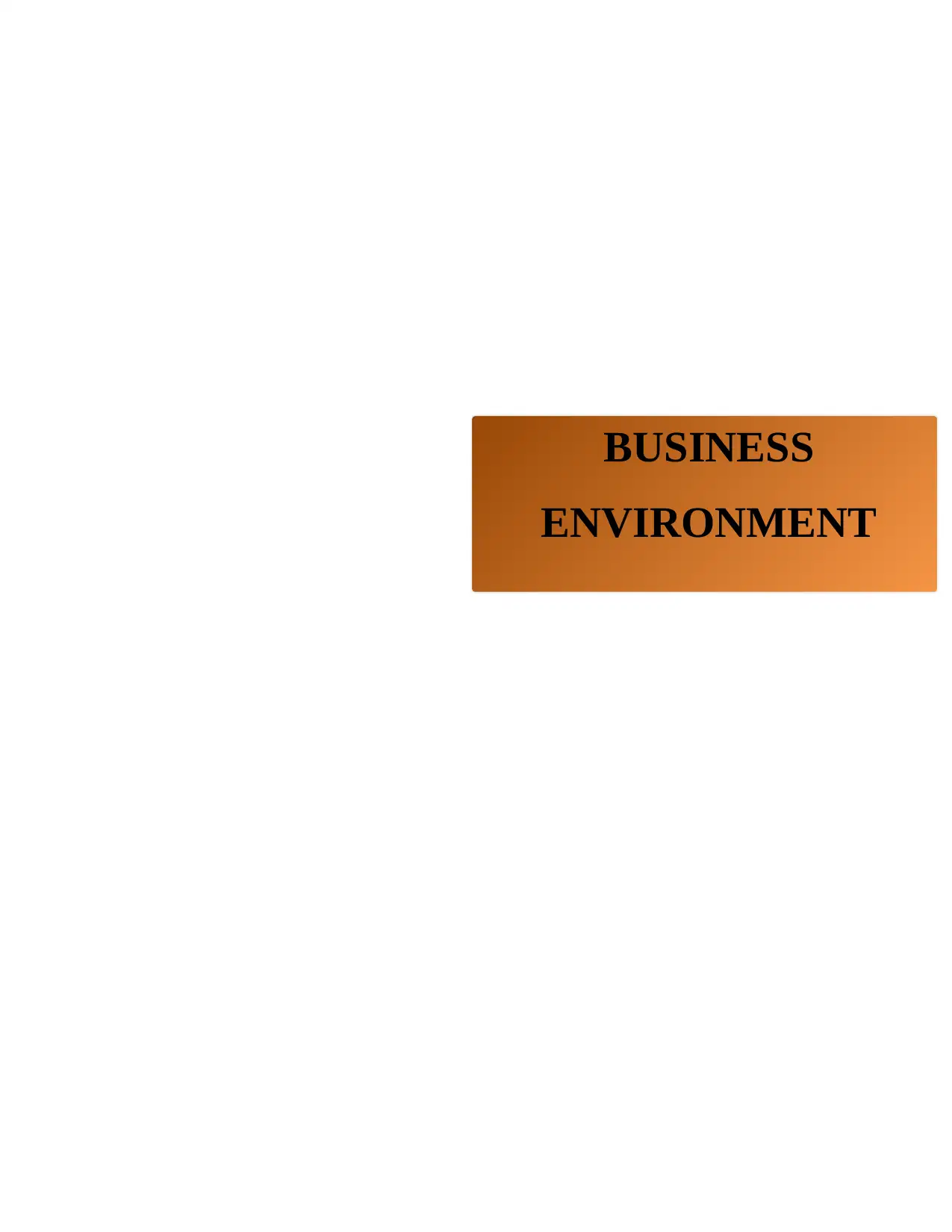
BUSINESS
ENVIRONMENT
ENVIRONMENT
Paraphrase This Document
Need a fresh take? Get an instant paraphrase of this document with our AI Paraphraser
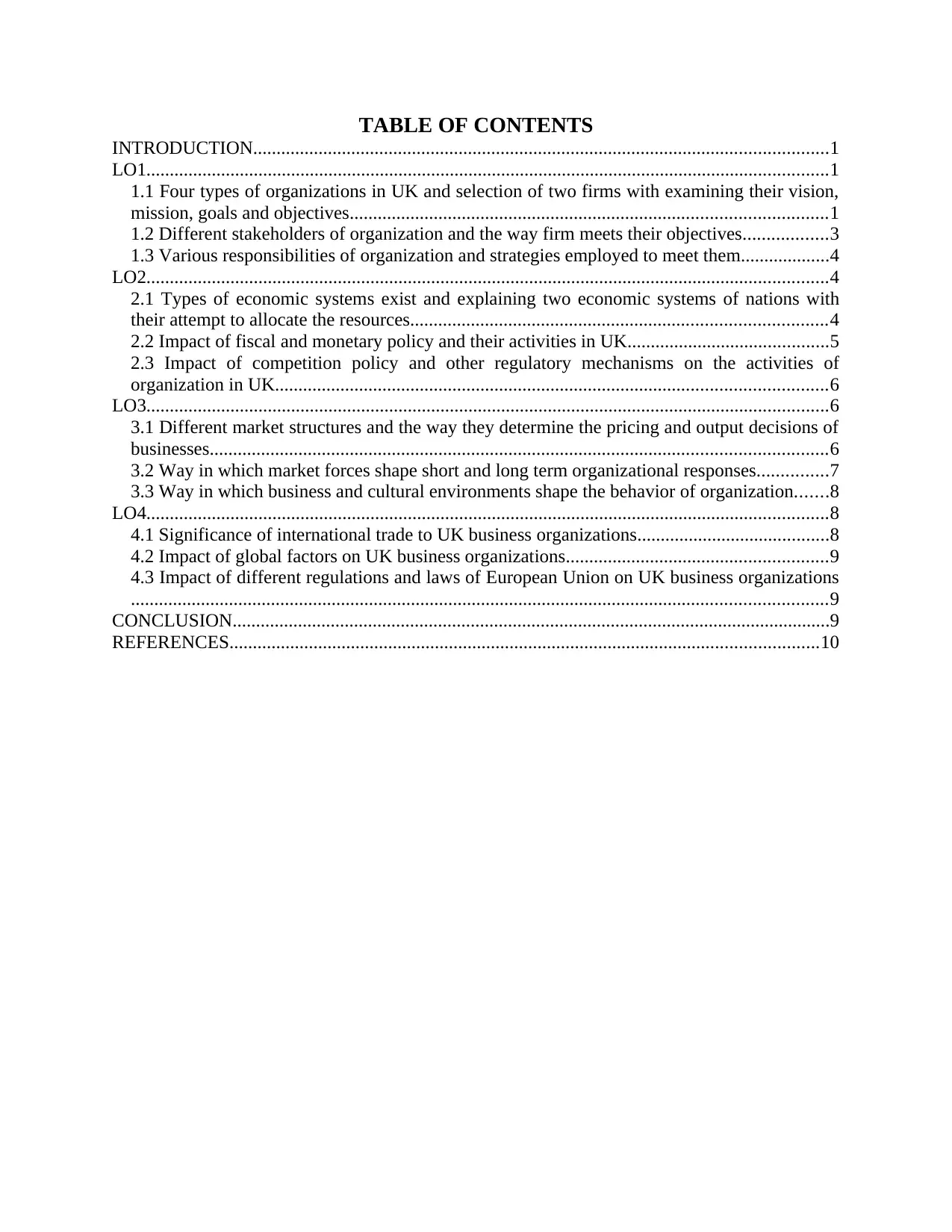
TABLE OF CONTENTS
INTRODUCTION...........................................................................................................................1
LO1..................................................................................................................................................1
1.1 Four types of organizations in UK and selection of two firms with examining their vision,
mission, goals and objectives......................................................................................................1
1.2 Different stakeholders of organization and the way firm meets their objectives..................3
1.3 Various responsibilities of organization and strategies employed to meet them...................4
LO2..................................................................................................................................................4
2.1 Types of economic systems exist and explaining two economic systems of nations with
their attempt to allocate the resources.........................................................................................4
2.2 Impact of fiscal and monetary policy and their activities in UK...........................................5
2.3 Impact of competition policy and other regulatory mechanisms on the activities of
organization in UK......................................................................................................................6
LO3..................................................................................................................................................6
3.1 Different market structures and the way they determine the pricing and output decisions of
businesses....................................................................................................................................6
3.2 Way in which market forces shape short and long term organizational responses...............7
3.3 Way in which business and cultural environments shape the behavior of organization.......8
LO4..................................................................................................................................................8
4.1 Significance of international trade to UK business organizations.........................................8
4.2 Impact of global factors on UK business organizations........................................................9
4.3 Impact of different regulations and laws of European Union on UK business organizations
.....................................................................................................................................................9
CONCLUSION................................................................................................................................9
REFERENCES..............................................................................................................................10
INTRODUCTION...........................................................................................................................1
LO1..................................................................................................................................................1
1.1 Four types of organizations in UK and selection of two firms with examining their vision,
mission, goals and objectives......................................................................................................1
1.2 Different stakeholders of organization and the way firm meets their objectives..................3
1.3 Various responsibilities of organization and strategies employed to meet them...................4
LO2..................................................................................................................................................4
2.1 Types of economic systems exist and explaining two economic systems of nations with
their attempt to allocate the resources.........................................................................................4
2.2 Impact of fiscal and monetary policy and their activities in UK...........................................5
2.3 Impact of competition policy and other regulatory mechanisms on the activities of
organization in UK......................................................................................................................6
LO3..................................................................................................................................................6
3.1 Different market structures and the way they determine the pricing and output decisions of
businesses....................................................................................................................................6
3.2 Way in which market forces shape short and long term organizational responses...............7
3.3 Way in which business and cultural environments shape the behavior of organization.......8
LO4..................................................................................................................................................8
4.1 Significance of international trade to UK business organizations.........................................8
4.2 Impact of global factors on UK business organizations........................................................9
4.3 Impact of different regulations and laws of European Union on UK business organizations
.....................................................................................................................................................9
CONCLUSION................................................................................................................................9
REFERENCES..............................................................................................................................10
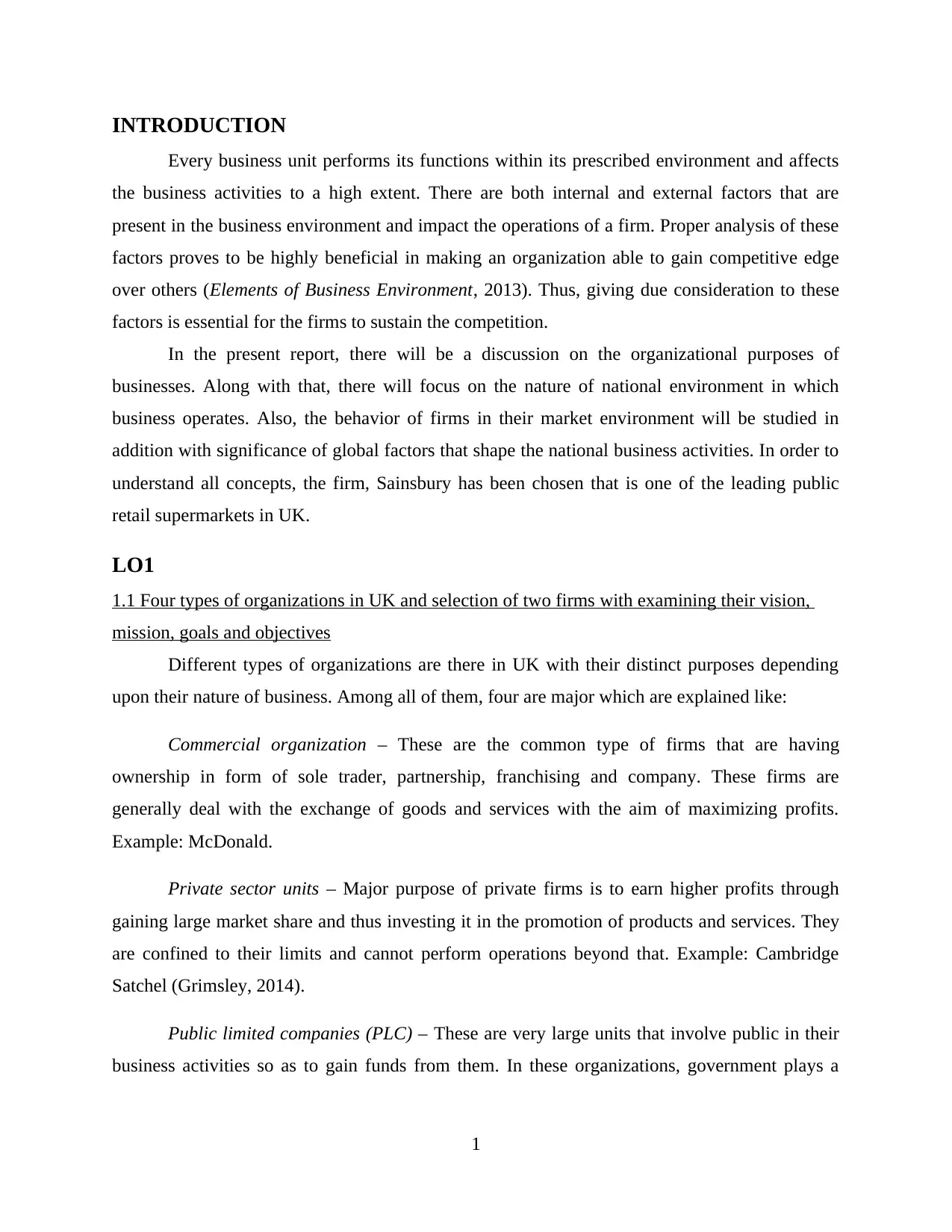
INTRODUCTION
Every business unit performs its functions within its prescribed environment and affects
the business activities to a high extent. There are both internal and external factors that are
present in the business environment and impact the operations of a firm. Proper analysis of these
factors proves to be highly beneficial in making an organization able to gain competitive edge
over others (Elements of Business Environment, 2013). Thus, giving due consideration to these
factors is essential for the firms to sustain the competition.
In the present report, there will be a discussion on the organizational purposes of
businesses. Along with that, there will focus on the nature of national environment in which
business operates. Also, the behavior of firms in their market environment will be studied in
addition with significance of global factors that shape the national business activities. In order to
understand all concepts, the firm, Sainsbury has been chosen that is one of the leading public
retail supermarkets in UK.
LO1
1.1 Four types of organizations in UK and selection of two firms with examining their vision,
mission, goals and objectives
Different types of organizations are there in UK with their distinct purposes depending
upon their nature of business. Among all of them, four are major which are explained like:
Commercial organization – These are the common type of firms that are having
ownership in form of sole trader, partnership, franchising and company. These firms are
generally deal with the exchange of goods and services with the aim of maximizing profits.
Example: McDonald.
Private sector units – Major purpose of private firms is to earn higher profits through
gaining large market share and thus investing it in the promotion of products and services. They
are confined to their limits and cannot perform operations beyond that. Example: Cambridge
Satchel (Grimsley, 2014).
Public limited companies (PLC) – These are very large units that involve public in their
business activities so as to gain funds from them. In these organizations, government plays a
1
Every business unit performs its functions within its prescribed environment and affects
the business activities to a high extent. There are both internal and external factors that are
present in the business environment and impact the operations of a firm. Proper analysis of these
factors proves to be highly beneficial in making an organization able to gain competitive edge
over others (Elements of Business Environment, 2013). Thus, giving due consideration to these
factors is essential for the firms to sustain the competition.
In the present report, there will be a discussion on the organizational purposes of
businesses. Along with that, there will focus on the nature of national environment in which
business operates. Also, the behavior of firms in their market environment will be studied in
addition with significance of global factors that shape the national business activities. In order to
understand all concepts, the firm, Sainsbury has been chosen that is one of the leading public
retail supermarkets in UK.
LO1
1.1 Four types of organizations in UK and selection of two firms with examining their vision,
mission, goals and objectives
Different types of organizations are there in UK with their distinct purposes depending
upon their nature of business. Among all of them, four are major which are explained like:
Commercial organization – These are the common type of firms that are having
ownership in form of sole trader, partnership, franchising and company. These firms are
generally deal with the exchange of goods and services with the aim of maximizing profits.
Example: McDonald.
Private sector units – Major purpose of private firms is to earn higher profits through
gaining large market share and thus investing it in the promotion of products and services. They
are confined to their limits and cannot perform operations beyond that. Example: Cambridge
Satchel (Grimsley, 2014).
Public limited companies (PLC) – These are very large units that involve public in their
business activities so as to gain funds from them. In these organizations, government plays a
1
⊘ This is a preview!⊘
Do you want full access?
Subscribe today to unlock all pages.

Trusted by 1+ million students worldwide
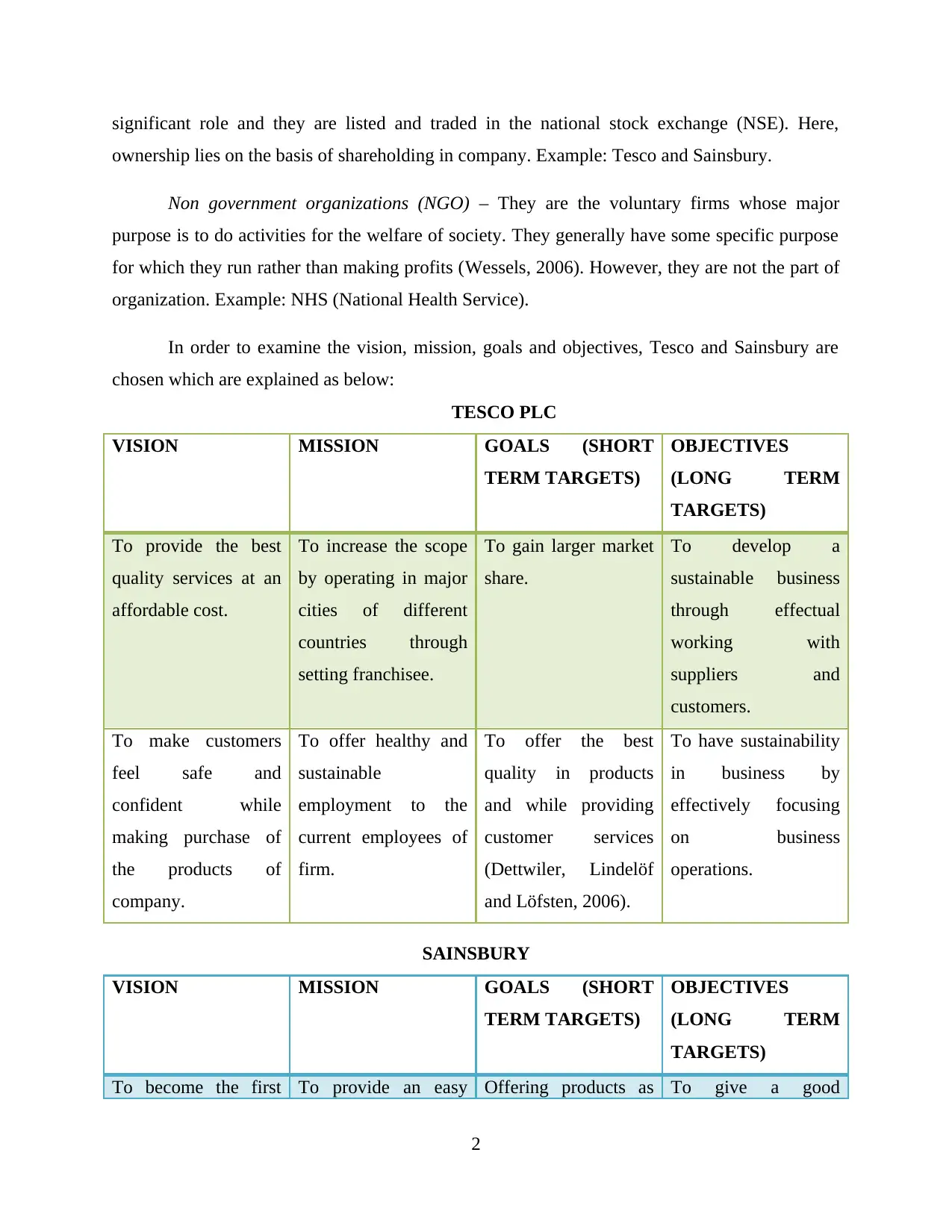
significant role and they are listed and traded in the national stock exchange (NSE). Here,
ownership lies on the basis of shareholding in company. Example: Tesco and Sainsbury.
Non government organizations (NGO) – They are the voluntary firms whose major
purpose is to do activities for the welfare of society. They generally have some specific purpose
for which they run rather than making profits (Wessels, 2006). However, they are not the part of
organization. Example: NHS (National Health Service).
In order to examine the vision, mission, goals and objectives, Tesco and Sainsbury are
chosen which are explained as below:
TESCO PLC
VISION MISSION GOALS (SHORT
TERM TARGETS)
OBJECTIVES
(LONG TERM
TARGETS)
To provide the best
quality services at an
affordable cost.
To increase the scope
by operating in major
cities of different
countries through
setting franchisee.
To gain larger market
share.
To develop a
sustainable business
through effectual
working with
suppliers and
customers.
To make customers
feel safe and
confident while
making purchase of
the products of
company.
To offer healthy and
sustainable
employment to the
current employees of
firm.
To offer the best
quality in products
and while providing
customer services
(Dettwiler, Lindelöf
and Löfsten, 2006).
To have sustainability
in business by
effectively focusing
on business
operations.
SAINSBURY
VISION MISSION GOALS (SHORT
TERM TARGETS)
OBJECTIVES
(LONG TERM
TARGETS)
To become the first To provide an easy Offering products as To give a good
2
ownership lies on the basis of shareholding in company. Example: Tesco and Sainsbury.
Non government organizations (NGO) – They are the voluntary firms whose major
purpose is to do activities for the welfare of society. They generally have some specific purpose
for which they run rather than making profits (Wessels, 2006). However, they are not the part of
organization. Example: NHS (National Health Service).
In order to examine the vision, mission, goals and objectives, Tesco and Sainsbury are
chosen which are explained as below:
TESCO PLC
VISION MISSION GOALS (SHORT
TERM TARGETS)
OBJECTIVES
(LONG TERM
TARGETS)
To provide the best
quality services at an
affordable cost.
To increase the scope
by operating in major
cities of different
countries through
setting franchisee.
To gain larger market
share.
To develop a
sustainable business
through effectual
working with
suppliers and
customers.
To make customers
feel safe and
confident while
making purchase of
the products of
company.
To offer healthy and
sustainable
employment to the
current employees of
firm.
To offer the best
quality in products
and while providing
customer services
(Dettwiler, Lindelöf
and Löfsten, 2006).
To have sustainability
in business by
effectively focusing
on business
operations.
SAINSBURY
VISION MISSION GOALS (SHORT
TERM TARGETS)
OBJECTIVES
(LONG TERM
TARGETS)
To become the first To provide an easy Offering products as To give a good
2
Paraphrase This Document
Need a fresh take? Get an instant paraphrase of this document with our AI Paraphraser
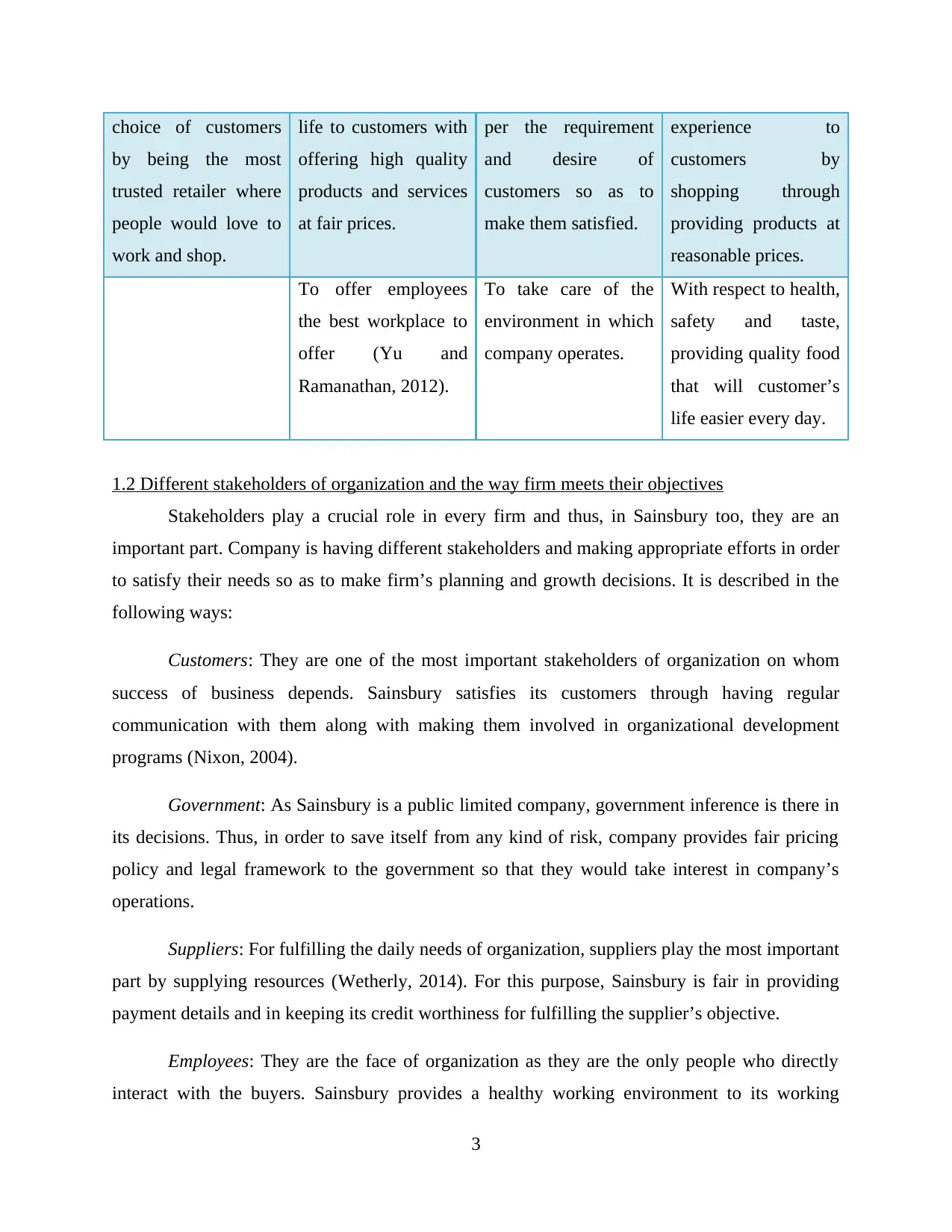
choice of customers
by being the most
trusted retailer where
people would love to
work and shop.
life to customers with
offering high quality
products and services
at fair prices.
per the requirement
and desire of
customers so as to
make them satisfied.
experience to
customers by
shopping through
providing products at
reasonable prices.
To offer employees
the best workplace to
offer (Yu and
Ramanathan, 2012).
To take care of the
environment in which
company operates.
With respect to health,
safety and taste,
providing quality food
that will customer’s
life easier every day.
1.2 Different stakeholders of organization and the way firm meets their objectives
Stakeholders play a crucial role in every firm and thus, in Sainsbury too, they are an
important part. Company is having different stakeholders and making appropriate efforts in order
to satisfy their needs so as to make firm’s planning and growth decisions. It is described in the
following ways:
Customers: They are one of the most important stakeholders of organization on whom
success of business depends. Sainsbury satisfies its customers through having regular
communication with them along with making them involved in organizational development
programs (Nixon, 2004).
Government: As Sainsbury is a public limited company, government inference is there in
its decisions. Thus, in order to save itself from any kind of risk, company provides fair pricing
policy and legal framework to the government so that they would take interest in company’s
operations.
Suppliers: For fulfilling the daily needs of organization, suppliers play the most important
part by supplying resources (Wetherly, 2014). For this purpose, Sainsbury is fair in providing
payment details and in keeping its credit worthiness for fulfilling the supplier’s objective.
Employees: They are the face of organization as they are the only people who directly
interact with the buyers. Sainsbury provides a healthy working environment to its working
3
by being the most
trusted retailer where
people would love to
work and shop.
life to customers with
offering high quality
products and services
at fair prices.
per the requirement
and desire of
customers so as to
make them satisfied.
experience to
customers by
shopping through
providing products at
reasonable prices.
To offer employees
the best workplace to
offer (Yu and
Ramanathan, 2012).
To take care of the
environment in which
company operates.
With respect to health,
safety and taste,
providing quality food
that will customer’s
life easier every day.
1.2 Different stakeholders of organization and the way firm meets their objectives
Stakeholders play a crucial role in every firm and thus, in Sainsbury too, they are an
important part. Company is having different stakeholders and making appropriate efforts in order
to satisfy their needs so as to make firm’s planning and growth decisions. It is described in the
following ways:
Customers: They are one of the most important stakeholders of organization on whom
success of business depends. Sainsbury satisfies its customers through having regular
communication with them along with making them involved in organizational development
programs (Nixon, 2004).
Government: As Sainsbury is a public limited company, government inference is there in
its decisions. Thus, in order to save itself from any kind of risk, company provides fair pricing
policy and legal framework to the government so that they would take interest in company’s
operations.
Suppliers: For fulfilling the daily needs of organization, suppliers play the most important
part by supplying resources (Wetherly, 2014). For this purpose, Sainsbury is fair in providing
payment details and in keeping its credit worthiness for fulfilling the supplier’s objective.
Employees: They are the face of organization as they are the only people who directly
interact with the buyers. Sainsbury provides a healthy working environment to its working
3
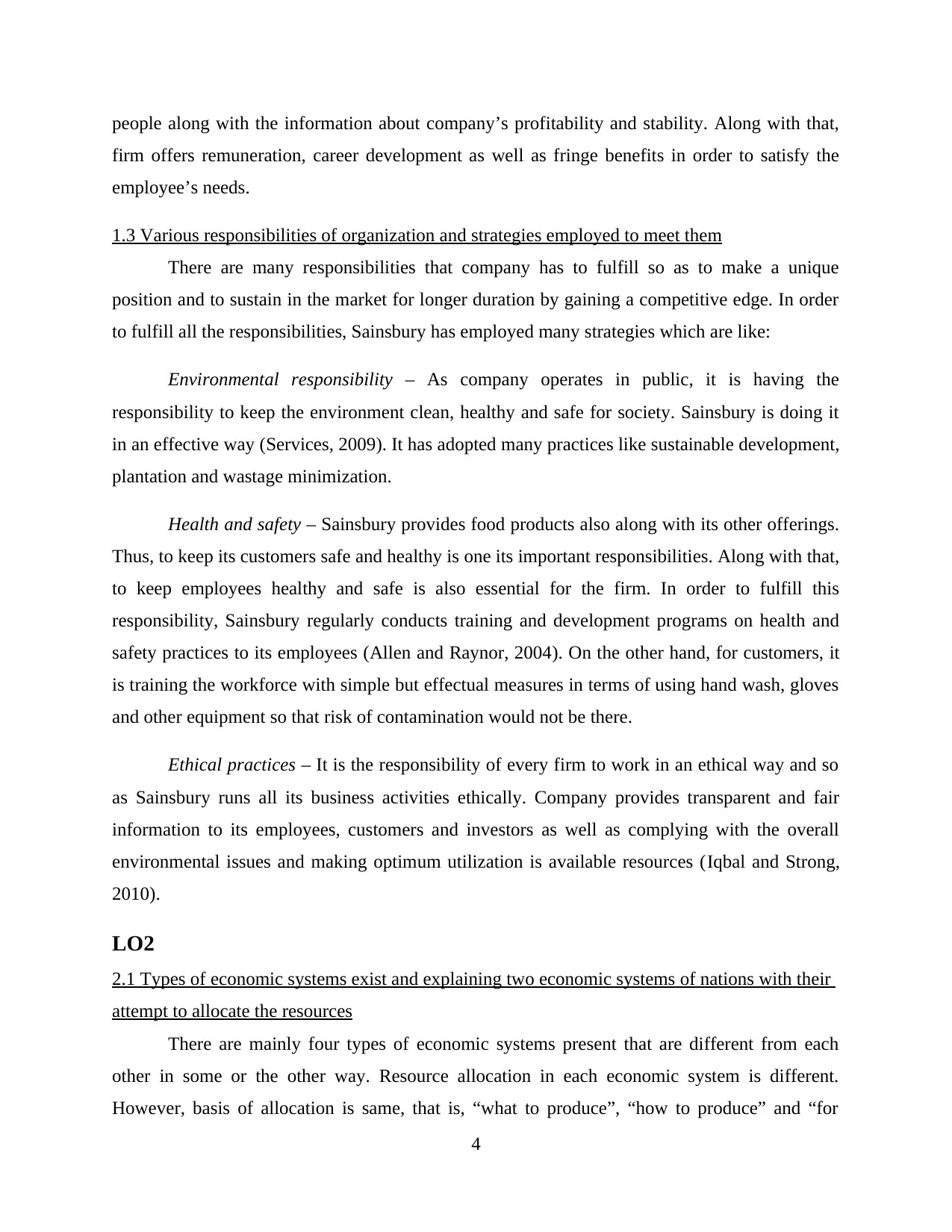
people along with the information about company’s profitability and stability. Along with that,
firm offers remuneration, career development as well as fringe benefits in order to satisfy the
employee’s needs.
1.3 Various responsibilities of organization and strategies employed to meet them
There are many responsibilities that company has to fulfill so as to make a unique
position and to sustain in the market for longer duration by gaining a competitive edge. In order
to fulfill all the responsibilities, Sainsbury has employed many strategies which are like:
Environmental responsibility – As company operates in public, it is having the
responsibility to keep the environment clean, healthy and safe for society. Sainsbury is doing it
in an effective way (Services, 2009). It has adopted many practices like sustainable development,
plantation and wastage minimization.
Health and safety – Sainsbury provides food products also along with its other offerings.
Thus, to keep its customers safe and healthy is one its important responsibilities. Along with that,
to keep employees healthy and safe is also essential for the firm. In order to fulfill this
responsibility, Sainsbury regularly conducts training and development programs on health and
safety practices to its employees (Allen and Raynor, 2004). On the other hand, for customers, it
is training the workforce with simple but effectual measures in terms of using hand wash, gloves
and other equipment so that risk of contamination would not be there.
Ethical practices – It is the responsibility of every firm to work in an ethical way and so
as Sainsbury runs all its business activities ethically. Company provides transparent and fair
information to its employees, customers and investors as well as complying with the overall
environmental issues and making optimum utilization is available resources (Iqbal and Strong,
2010).
LO2
2.1 Types of economic systems exist and explaining two economic systems of nations with their
attempt to allocate the resources
There are mainly four types of economic systems present that are different from each
other in some or the other way. Resource allocation in each economic system is different.
However, basis of allocation is same, that is, “what to produce”, “how to produce” and “for
4
firm offers remuneration, career development as well as fringe benefits in order to satisfy the
employee’s needs.
1.3 Various responsibilities of organization and strategies employed to meet them
There are many responsibilities that company has to fulfill so as to make a unique
position and to sustain in the market for longer duration by gaining a competitive edge. In order
to fulfill all the responsibilities, Sainsbury has employed many strategies which are like:
Environmental responsibility – As company operates in public, it is having the
responsibility to keep the environment clean, healthy and safe for society. Sainsbury is doing it
in an effective way (Services, 2009). It has adopted many practices like sustainable development,
plantation and wastage minimization.
Health and safety – Sainsbury provides food products also along with its other offerings.
Thus, to keep its customers safe and healthy is one its important responsibilities. Along with that,
to keep employees healthy and safe is also essential for the firm. In order to fulfill this
responsibility, Sainsbury regularly conducts training and development programs on health and
safety practices to its employees (Allen and Raynor, 2004). On the other hand, for customers, it
is training the workforce with simple but effectual measures in terms of using hand wash, gloves
and other equipment so that risk of contamination would not be there.
Ethical practices – It is the responsibility of every firm to work in an ethical way and so
as Sainsbury runs all its business activities ethically. Company provides transparent and fair
information to its employees, customers and investors as well as complying with the overall
environmental issues and making optimum utilization is available resources (Iqbal and Strong,
2010).
LO2
2.1 Types of economic systems exist and explaining two economic systems of nations with their
attempt to allocate the resources
There are mainly four types of economic systems present that are different from each
other in some or the other way. Resource allocation in each economic system is different.
However, basis of allocation is same, that is, “what to produce”, “how to produce” and “for
4
⊘ This is a preview!⊘
Do you want full access?
Subscribe today to unlock all pages.

Trusted by 1+ million students worldwide
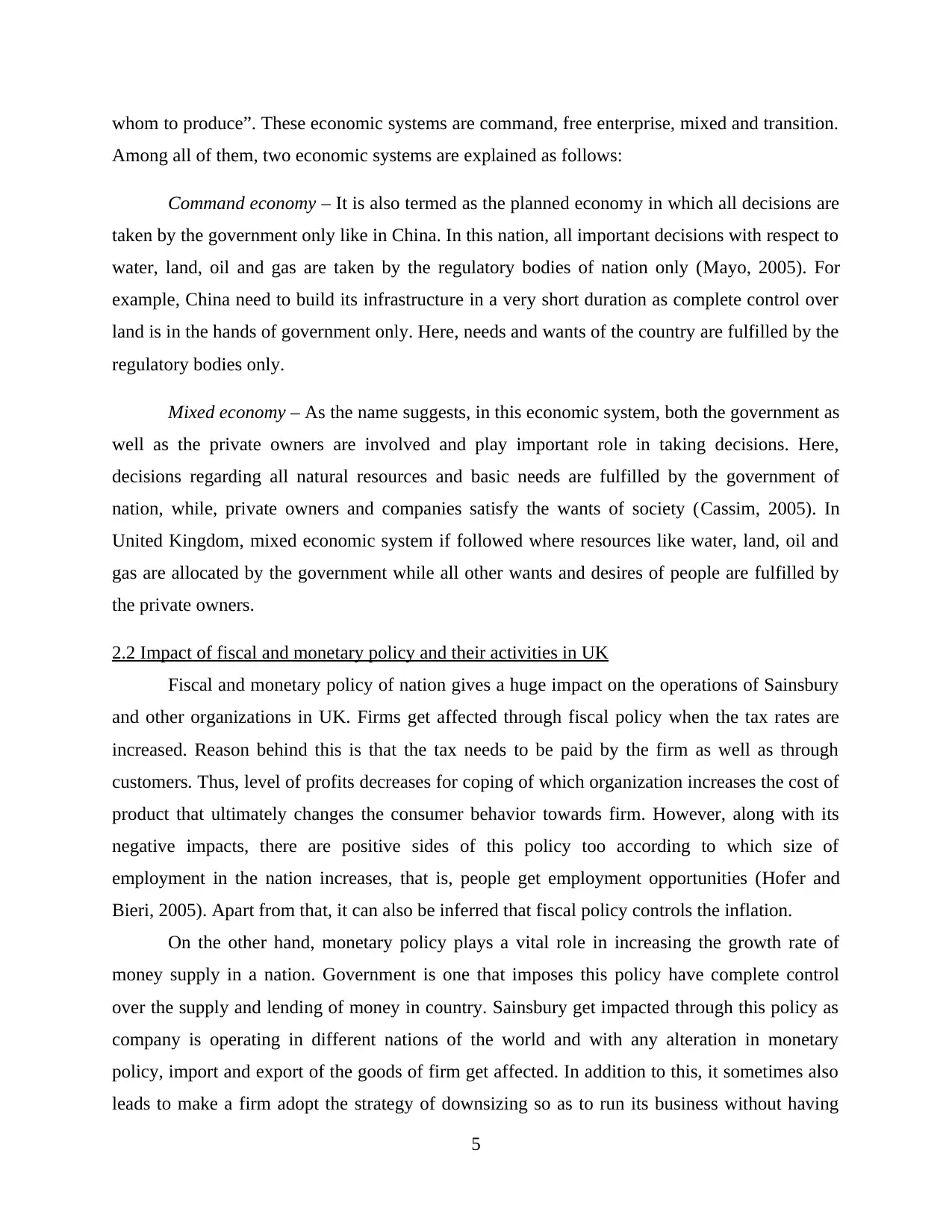
whom to produce”. These economic systems are command, free enterprise, mixed and transition.
Among all of them, two economic systems are explained as follows:
Command economy – It is also termed as the planned economy in which all decisions are
taken by the government only like in China. In this nation, all important decisions with respect to
water, land, oil and gas are taken by the regulatory bodies of nation only (Mayo, 2005). For
example, China need to build its infrastructure in a very short duration as complete control over
land is in the hands of government only. Here, needs and wants of the country are fulfilled by the
regulatory bodies only.
Mixed economy – As the name suggests, in this economic system, both the government as
well as the private owners are involved and play important role in taking decisions. Here,
decisions regarding all natural resources and basic needs are fulfilled by the government of
nation, while, private owners and companies satisfy the wants of society (Cassim, 2005). In
United Kingdom, mixed economic system if followed where resources like water, land, oil and
gas are allocated by the government while all other wants and desires of people are fulfilled by
the private owners.
2.2 Impact of fiscal and monetary policy and their activities in UK
Fiscal and monetary policy of nation gives a huge impact on the operations of Sainsbury
and other organizations in UK. Firms get affected through fiscal policy when the tax rates are
increased. Reason behind this is that the tax needs to be paid by the firm as well as through
customers. Thus, level of profits decreases for coping of which organization increases the cost of
product that ultimately changes the consumer behavior towards firm. However, along with its
negative impacts, there are positive sides of this policy too according to which size of
employment in the nation increases, that is, people get employment opportunities (Hofer and
Bieri, 2005). Apart from that, it can also be inferred that fiscal policy controls the inflation.
On the other hand, monetary policy plays a vital role in increasing the growth rate of
money supply in a nation. Government is one that imposes this policy have complete control
over the supply and lending of money in country. Sainsbury get impacted through this policy as
company is operating in different nations of the world and with any alteration in monetary
policy, import and export of the goods of firm get affected. In addition to this, it sometimes also
leads to make a firm adopt the strategy of downsizing so as to run its business without having
5
Among all of them, two economic systems are explained as follows:
Command economy – It is also termed as the planned economy in which all decisions are
taken by the government only like in China. In this nation, all important decisions with respect to
water, land, oil and gas are taken by the regulatory bodies of nation only (Mayo, 2005). For
example, China need to build its infrastructure in a very short duration as complete control over
land is in the hands of government only. Here, needs and wants of the country are fulfilled by the
regulatory bodies only.
Mixed economy – As the name suggests, in this economic system, both the government as
well as the private owners are involved and play important role in taking decisions. Here,
decisions regarding all natural resources and basic needs are fulfilled by the government of
nation, while, private owners and companies satisfy the wants of society (Cassim, 2005). In
United Kingdom, mixed economic system if followed where resources like water, land, oil and
gas are allocated by the government while all other wants and desires of people are fulfilled by
the private owners.
2.2 Impact of fiscal and monetary policy and their activities in UK
Fiscal and monetary policy of nation gives a huge impact on the operations of Sainsbury
and other organizations in UK. Firms get affected through fiscal policy when the tax rates are
increased. Reason behind this is that the tax needs to be paid by the firm as well as through
customers. Thus, level of profits decreases for coping of which organization increases the cost of
product that ultimately changes the consumer behavior towards firm. However, along with its
negative impacts, there are positive sides of this policy too according to which size of
employment in the nation increases, that is, people get employment opportunities (Hofer and
Bieri, 2005). Apart from that, it can also be inferred that fiscal policy controls the inflation.
On the other hand, monetary policy plays a vital role in increasing the growth rate of
money supply in a nation. Government is one that imposes this policy have complete control
over the supply and lending of money in country. Sainsbury get impacted through this policy as
company is operating in different nations of the world and with any alteration in monetary
policy, import and export of the goods of firm get affected. In addition to this, it sometimes also
leads to make a firm adopt the strategy of downsizing so as to run its business without having
5
Paraphrase This Document
Need a fresh take? Get an instant paraphrase of this document with our AI Paraphraser
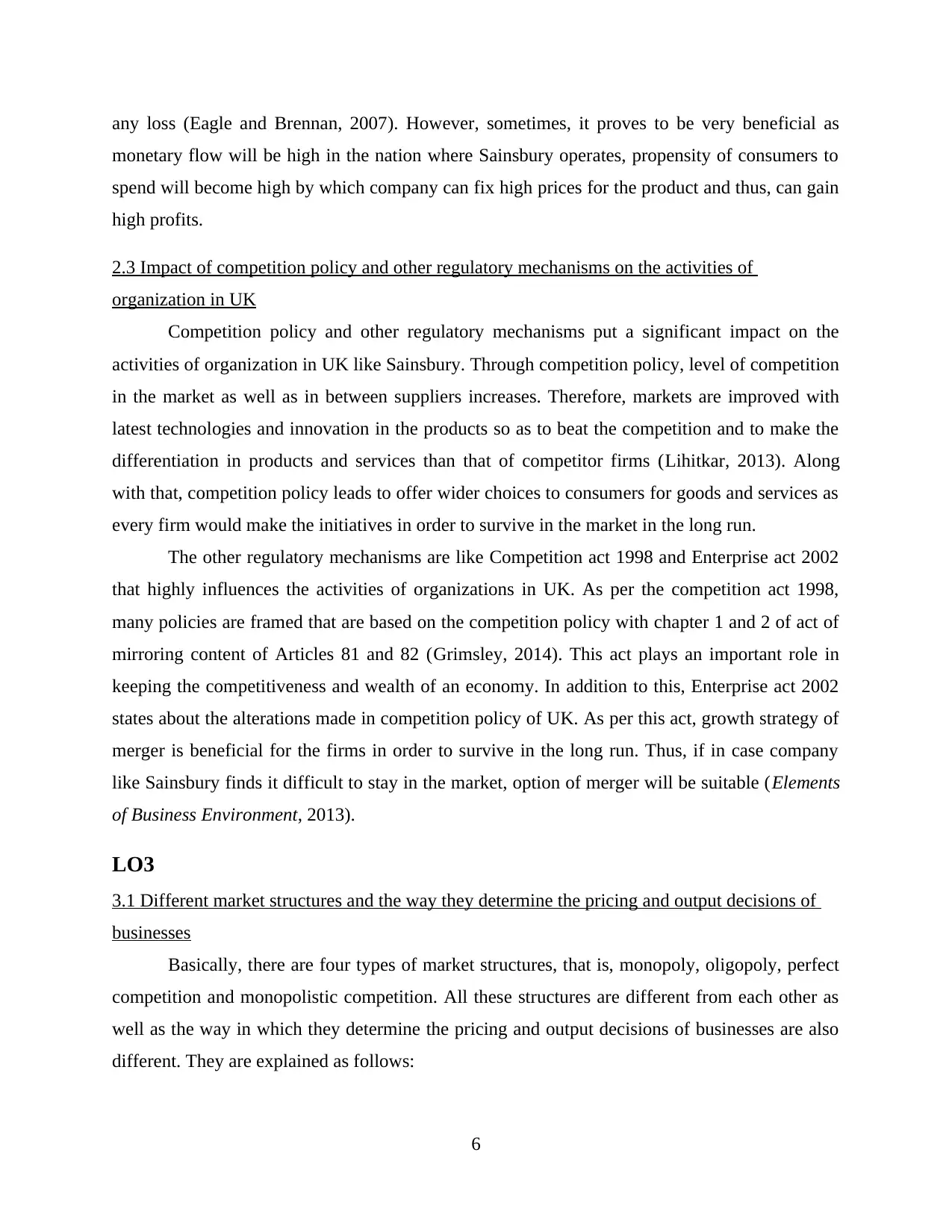
any loss (Eagle and Brennan, 2007). However, sometimes, it proves to be very beneficial as
monetary flow will be high in the nation where Sainsbury operates, propensity of consumers to
spend will become high by which company can fix high prices for the product and thus, can gain
high profits.
2.3 Impact of competition policy and other regulatory mechanisms on the activities of
organization in UK
Competition policy and other regulatory mechanisms put a significant impact on the
activities of organization in UK like Sainsbury. Through competition policy, level of competition
in the market as well as in between suppliers increases. Therefore, markets are improved with
latest technologies and innovation in the products so as to beat the competition and to make the
differentiation in products and services than that of competitor firms (Lihitkar, 2013). Along
with that, competition policy leads to offer wider choices to consumers for goods and services as
every firm would make the initiatives in order to survive in the market in the long run.
The other regulatory mechanisms are like Competition act 1998 and Enterprise act 2002
that highly influences the activities of organizations in UK. As per the competition act 1998,
many policies are framed that are based on the competition policy with chapter 1 and 2 of act of
mirroring content of Articles 81 and 82 (Grimsley, 2014). This act plays an important role in
keeping the competitiveness and wealth of an economy. In addition to this, Enterprise act 2002
states about the alterations made in competition policy of UK. As per this act, growth strategy of
merger is beneficial for the firms in order to survive in the long run. Thus, if in case company
like Sainsbury finds it difficult to stay in the market, option of merger will be suitable (Elements
of Business Environment, 2013).
LO3
3.1 Different market structures and the way they determine the pricing and output decisions of
businesses
Basically, there are four types of market structures, that is, monopoly, oligopoly, perfect
competition and monopolistic competition. All these structures are different from each other as
well as the way in which they determine the pricing and output decisions of businesses are also
different. They are explained as follows:
6
monetary flow will be high in the nation where Sainsbury operates, propensity of consumers to
spend will become high by which company can fix high prices for the product and thus, can gain
high profits.
2.3 Impact of competition policy and other regulatory mechanisms on the activities of
organization in UK
Competition policy and other regulatory mechanisms put a significant impact on the
activities of organization in UK like Sainsbury. Through competition policy, level of competition
in the market as well as in between suppliers increases. Therefore, markets are improved with
latest technologies and innovation in the products so as to beat the competition and to make the
differentiation in products and services than that of competitor firms (Lihitkar, 2013). Along
with that, competition policy leads to offer wider choices to consumers for goods and services as
every firm would make the initiatives in order to survive in the market in the long run.
The other regulatory mechanisms are like Competition act 1998 and Enterprise act 2002
that highly influences the activities of organizations in UK. As per the competition act 1998,
many policies are framed that are based on the competition policy with chapter 1 and 2 of act of
mirroring content of Articles 81 and 82 (Grimsley, 2014). This act plays an important role in
keeping the competitiveness and wealth of an economy. In addition to this, Enterprise act 2002
states about the alterations made in competition policy of UK. As per this act, growth strategy of
merger is beneficial for the firms in order to survive in the long run. Thus, if in case company
like Sainsbury finds it difficult to stay in the market, option of merger will be suitable (Elements
of Business Environment, 2013).
LO3
3.1 Different market structures and the way they determine the pricing and output decisions of
businesses
Basically, there are four types of market structures, that is, monopoly, oligopoly, perfect
competition and monopolistic competition. All these structures are different from each other as
well as the way in which they determine the pricing and output decisions of businesses are also
different. They are explained as follows:
6
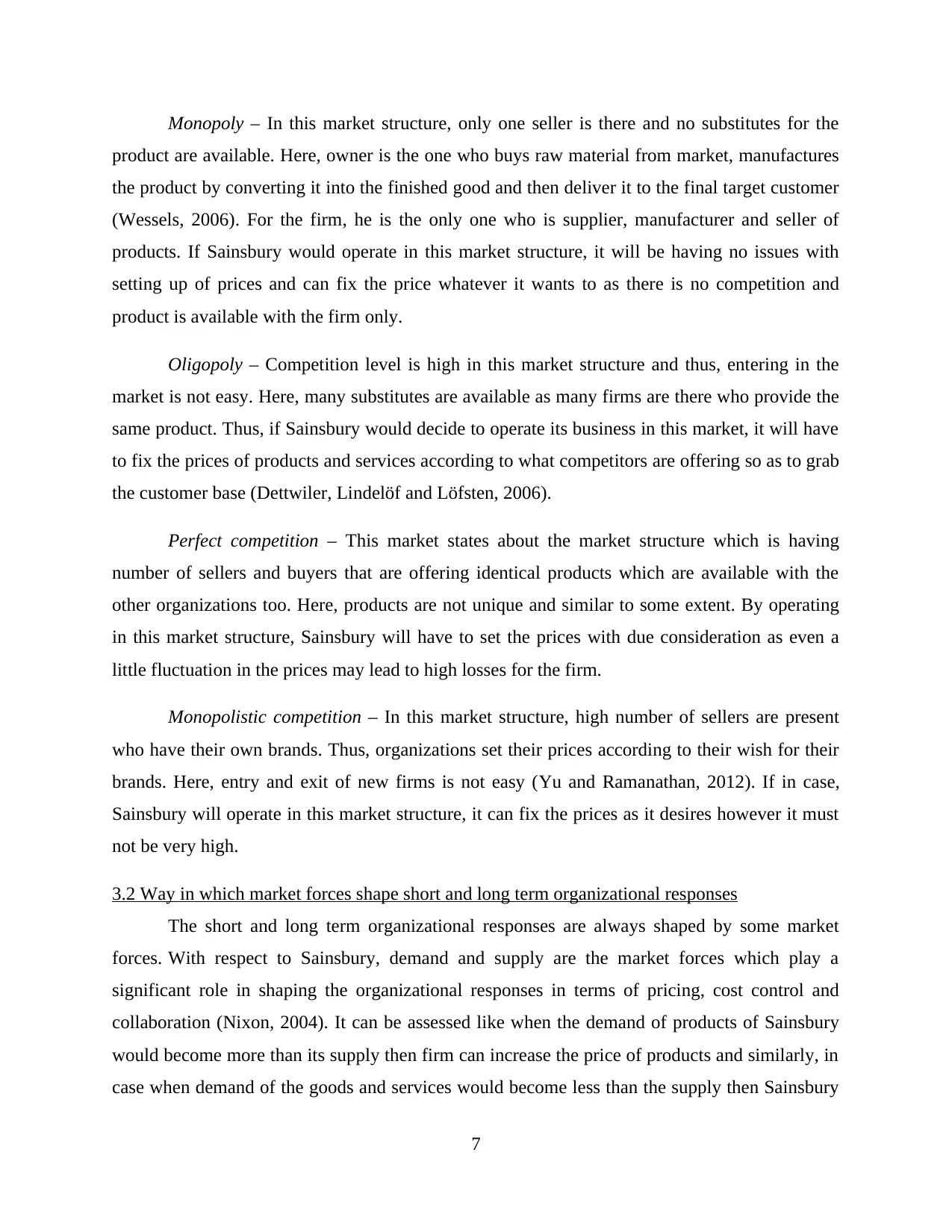
Monopoly – In this market structure, only one seller is there and no substitutes for the
product are available. Here, owner is the one who buys raw material from market, manufactures
the product by converting it into the finished good and then deliver it to the final target customer
(Wessels, 2006). For the firm, he is the only one who is supplier, manufacturer and seller of
products. If Sainsbury would operate in this market structure, it will be having no issues with
setting up of prices and can fix the price whatever it wants to as there is no competition and
product is available with the firm only.
Oligopoly – Competition level is high in this market structure and thus, entering in the
market is not easy. Here, many substitutes are available as many firms are there who provide the
same product. Thus, if Sainsbury would decide to operate its business in this market, it will have
to fix the prices of products and services according to what competitors are offering so as to grab
the customer base (Dettwiler, Lindelöf and Löfsten, 2006).
Perfect competition – This market states about the market structure which is having
number of sellers and buyers that are offering identical products which are available with the
other organizations too. Here, products are not unique and similar to some extent. By operating
in this market structure, Sainsbury will have to set the prices with due consideration as even a
little fluctuation in the prices may lead to high losses for the firm.
Monopolistic competition – In this market structure, high number of sellers are present
who have their own brands. Thus, organizations set their prices according to their wish for their
brands. Here, entry and exit of new firms is not easy (Yu and Ramanathan, 2012). If in case,
Sainsbury will operate in this market structure, it can fix the prices as it desires however it must
not be very high.
3.2 Way in which market forces shape short and long term organizational responses
The short and long term organizational responses are always shaped by some market
forces. With respect to Sainsbury, demand and supply are the market forces which play a
significant role in shaping the organizational responses in terms of pricing, cost control and
collaboration (Nixon, 2004). It can be assessed like when the demand of products of Sainsbury
would become more than its supply then firm can increase the price of products and similarly, in
case when demand of the goods and services would become less than the supply then Sainsbury
7
product are available. Here, owner is the one who buys raw material from market, manufactures
the product by converting it into the finished good and then deliver it to the final target customer
(Wessels, 2006). For the firm, he is the only one who is supplier, manufacturer and seller of
products. If Sainsbury would operate in this market structure, it will be having no issues with
setting up of prices and can fix the price whatever it wants to as there is no competition and
product is available with the firm only.
Oligopoly – Competition level is high in this market structure and thus, entering in the
market is not easy. Here, many substitutes are available as many firms are there who provide the
same product. Thus, if Sainsbury would decide to operate its business in this market, it will have
to fix the prices of products and services according to what competitors are offering so as to grab
the customer base (Dettwiler, Lindelöf and Löfsten, 2006).
Perfect competition – This market states about the market structure which is having
number of sellers and buyers that are offering identical products which are available with the
other organizations too. Here, products are not unique and similar to some extent. By operating
in this market structure, Sainsbury will have to set the prices with due consideration as even a
little fluctuation in the prices may lead to high losses for the firm.
Monopolistic competition – In this market structure, high number of sellers are present
who have their own brands. Thus, organizations set their prices according to their wish for their
brands. Here, entry and exit of new firms is not easy (Yu and Ramanathan, 2012). If in case,
Sainsbury will operate in this market structure, it can fix the prices as it desires however it must
not be very high.
3.2 Way in which market forces shape short and long term organizational responses
The short and long term organizational responses are always shaped by some market
forces. With respect to Sainsbury, demand and supply are the market forces which play a
significant role in shaping the organizational responses in terms of pricing, cost control and
collaboration (Nixon, 2004). It can be assessed like when the demand of products of Sainsbury
would become more than its supply then firm can increase the price of products and similarly, in
case when demand of the goods and services would become less than the supply then Sainsbury
7
⊘ This is a preview!⊘
Do you want full access?
Subscribe today to unlock all pages.

Trusted by 1+ million students worldwide
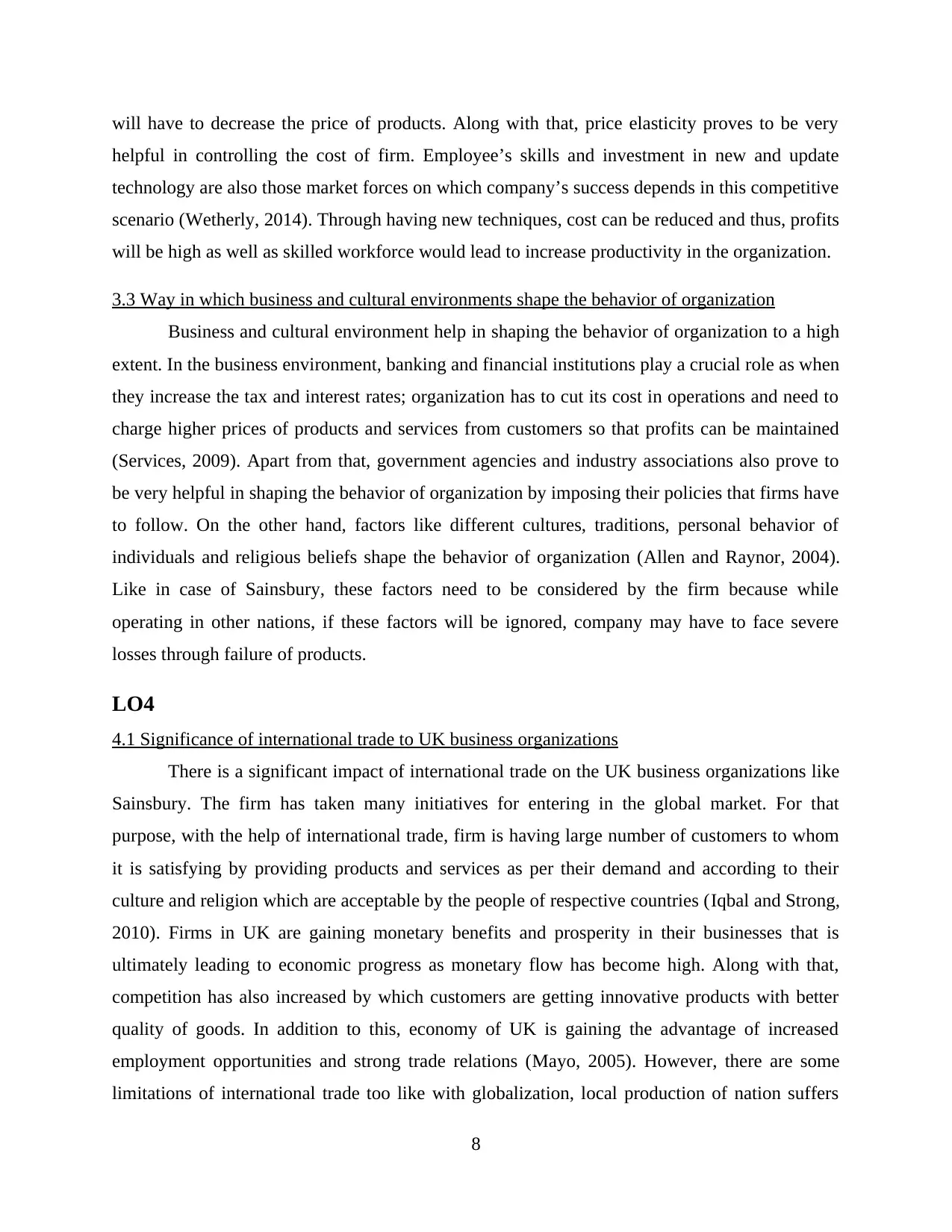
will have to decrease the price of products. Along with that, price elasticity proves to be very
helpful in controlling the cost of firm. Employee’s skills and investment in new and update
technology are also those market forces on which company’s success depends in this competitive
scenario (Wetherly, 2014). Through having new techniques, cost can be reduced and thus, profits
will be high as well as skilled workforce would lead to increase productivity in the organization.
3.3 Way in which business and cultural environments shape the behavior of organization
Business and cultural environment help in shaping the behavior of organization to a high
extent. In the business environment, banking and financial institutions play a crucial role as when
they increase the tax and interest rates; organization has to cut its cost in operations and need to
charge higher prices of products and services from customers so that profits can be maintained
(Services, 2009). Apart from that, government agencies and industry associations also prove to
be very helpful in shaping the behavior of organization by imposing their policies that firms have
to follow. On the other hand, factors like different cultures, traditions, personal behavior of
individuals and religious beliefs shape the behavior of organization (Allen and Raynor, 2004).
Like in case of Sainsbury, these factors need to be considered by the firm because while
operating in other nations, if these factors will be ignored, company may have to face severe
losses through failure of products.
LO4
4.1 Significance of international trade to UK business organizations
There is a significant impact of international trade on the UK business organizations like
Sainsbury. The firm has taken many initiatives for entering in the global market. For that
purpose, with the help of international trade, firm is having large number of customers to whom
it is satisfying by providing products and services as per their demand and according to their
culture and religion which are acceptable by the people of respective countries (Iqbal and Strong,
2010). Firms in UK are gaining monetary benefits and prosperity in their businesses that is
ultimately leading to economic progress as monetary flow has become high. Along with that,
competition has also increased by which customers are getting innovative products with better
quality of goods. In addition to this, economy of UK is gaining the advantage of increased
employment opportunities and strong trade relations (Mayo, 2005). However, there are some
limitations of international trade too like with globalization, local production of nation suffers
8
helpful in controlling the cost of firm. Employee’s skills and investment in new and update
technology are also those market forces on which company’s success depends in this competitive
scenario (Wetherly, 2014). Through having new techniques, cost can be reduced and thus, profits
will be high as well as skilled workforce would lead to increase productivity in the organization.
3.3 Way in which business and cultural environments shape the behavior of organization
Business and cultural environment help in shaping the behavior of organization to a high
extent. In the business environment, banking and financial institutions play a crucial role as when
they increase the tax and interest rates; organization has to cut its cost in operations and need to
charge higher prices of products and services from customers so that profits can be maintained
(Services, 2009). Apart from that, government agencies and industry associations also prove to
be very helpful in shaping the behavior of organization by imposing their policies that firms have
to follow. On the other hand, factors like different cultures, traditions, personal behavior of
individuals and religious beliefs shape the behavior of organization (Allen and Raynor, 2004).
Like in case of Sainsbury, these factors need to be considered by the firm because while
operating in other nations, if these factors will be ignored, company may have to face severe
losses through failure of products.
LO4
4.1 Significance of international trade to UK business organizations
There is a significant impact of international trade on the UK business organizations like
Sainsbury. The firm has taken many initiatives for entering in the global market. For that
purpose, with the help of international trade, firm is having large number of customers to whom
it is satisfying by providing products and services as per their demand and according to their
culture and religion which are acceptable by the people of respective countries (Iqbal and Strong,
2010). Firms in UK are gaining monetary benefits and prosperity in their businesses that is
ultimately leading to economic progress as monetary flow has become high. Along with that,
competition has also increased by which customers are getting innovative products with better
quality of goods. In addition to this, economy of UK is gaining the advantage of increased
employment opportunities and strong trade relations (Mayo, 2005). However, there are some
limitations of international trade too like with globalization, local production of nation suffers
8
Paraphrase This Document
Need a fresh take? Get an instant paraphrase of this document with our AI Paraphraser
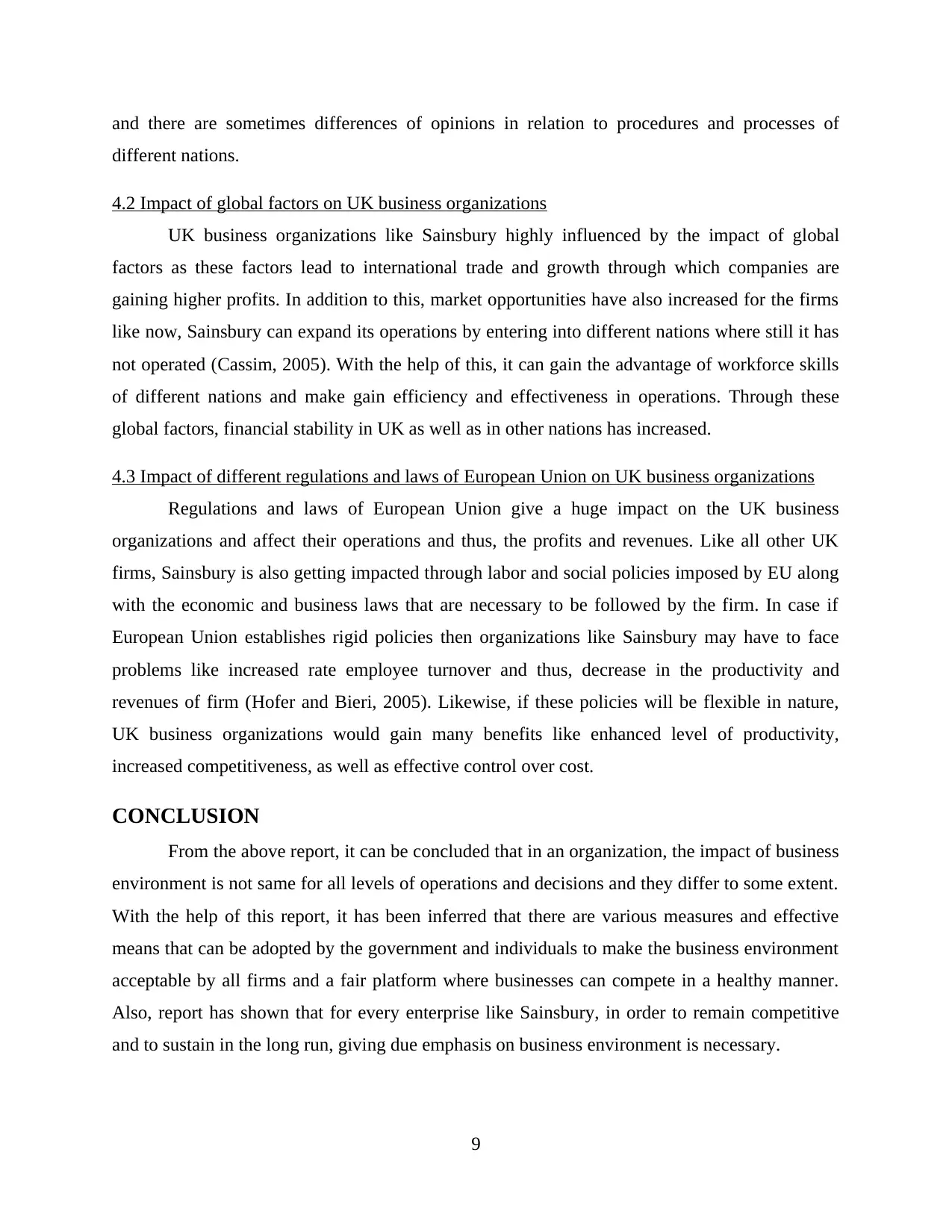
and there are sometimes differences of opinions in relation to procedures and processes of
different nations.
4.2 Impact of global factors on UK business organizations
UK business organizations like Sainsbury highly influenced by the impact of global
factors as these factors lead to international trade and growth through which companies are
gaining higher profits. In addition to this, market opportunities have also increased for the firms
like now, Sainsbury can expand its operations by entering into different nations where still it has
not operated (Cassim, 2005). With the help of this, it can gain the advantage of workforce skills
of different nations and make gain efficiency and effectiveness in operations. Through these
global factors, financial stability in UK as well as in other nations has increased.
4.3 Impact of different regulations and laws of European Union on UK business organizations
Regulations and laws of European Union give a huge impact on the UK business
organizations and affect their operations and thus, the profits and revenues. Like all other UK
firms, Sainsbury is also getting impacted through labor and social policies imposed by EU along
with the economic and business laws that are necessary to be followed by the firm. In case if
European Union establishes rigid policies then organizations like Sainsbury may have to face
problems like increased rate employee turnover and thus, decrease in the productivity and
revenues of firm (Hofer and Bieri, 2005). Likewise, if these policies will be flexible in nature,
UK business organizations would gain many benefits like enhanced level of productivity,
increased competitiveness, as well as effective control over cost.
CONCLUSION
From the above report, it can be concluded that in an organization, the impact of business
environment is not same for all levels of operations and decisions and they differ to some extent.
With the help of this report, it has been inferred that there are various measures and effective
means that can be adopted by the government and individuals to make the business environment
acceptable by all firms and a fair platform where businesses can compete in a healthy manner.
Also, report has shown that for every enterprise like Sainsbury, in order to remain competitive
and to sustain in the long run, giving due emphasis on business environment is necessary.
9
different nations.
4.2 Impact of global factors on UK business organizations
UK business organizations like Sainsbury highly influenced by the impact of global
factors as these factors lead to international trade and growth through which companies are
gaining higher profits. In addition to this, market opportunities have also increased for the firms
like now, Sainsbury can expand its operations by entering into different nations where still it has
not operated (Cassim, 2005). With the help of this, it can gain the advantage of workforce skills
of different nations and make gain efficiency and effectiveness in operations. Through these
global factors, financial stability in UK as well as in other nations has increased.
4.3 Impact of different regulations and laws of European Union on UK business organizations
Regulations and laws of European Union give a huge impact on the UK business
organizations and affect their operations and thus, the profits and revenues. Like all other UK
firms, Sainsbury is also getting impacted through labor and social policies imposed by EU along
with the economic and business laws that are necessary to be followed by the firm. In case if
European Union establishes rigid policies then organizations like Sainsbury may have to face
problems like increased rate employee turnover and thus, decrease in the productivity and
revenues of firm (Hofer and Bieri, 2005). Likewise, if these policies will be flexible in nature,
UK business organizations would gain many benefits like enhanced level of productivity,
increased competitiveness, as well as effective control over cost.
CONCLUSION
From the above report, it can be concluded that in an organization, the impact of business
environment is not same for all levels of operations and decisions and they differ to some extent.
With the help of this report, it has been inferred that there are various measures and effective
means that can be adopted by the government and individuals to make the business environment
acceptable by all firms and a fair platform where businesses can compete in a healthy manner.
Also, report has shown that for every enterprise like Sainsbury, in order to remain competitive
and to sustain in the long run, giving due emphasis on business environment is necessary.
9
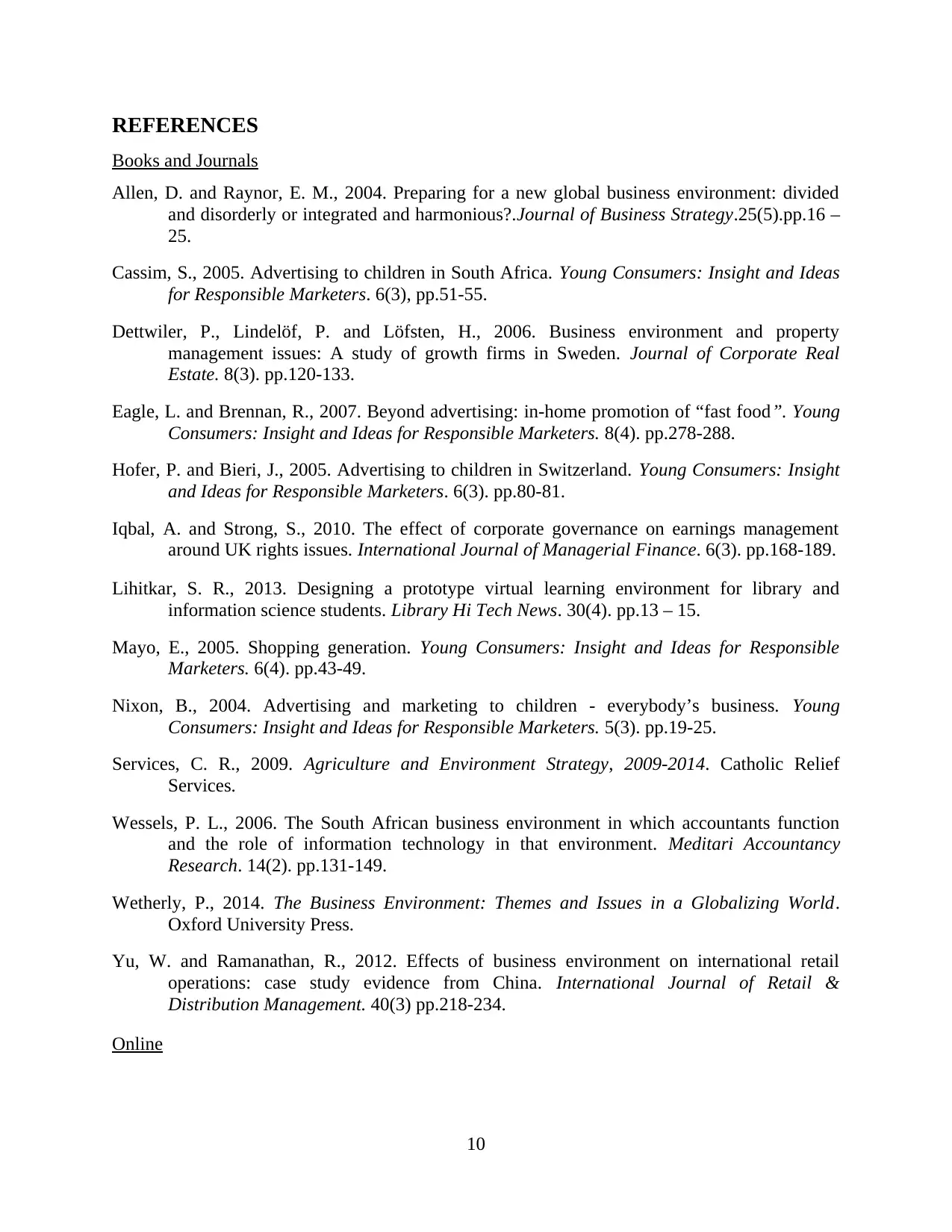
REFERENCES
Books and Journals
Allen, D. and Raynor, E. M., 2004. Preparing for a new global business environment: divided
and disorderly or integrated and harmonious?.Journal of Business Strategy.25(5).pp.16 –
25.
Cassim, S., 2005. Advertising to children in South Africa. Young Consumers: Insight and Ideas
for Responsible Marketers. 6(3), pp.51-55.
Dettwiler, P., Lindelöf, P. and Löfsten, H., 2006. Business environment and property
management issues: A study of growth firms in Sweden. Journal of Corporate Real
Estate. 8(3). pp.120-133.
Eagle, L. and Brennan, R., 2007. Beyond advertising: in-home promotion of “fast food”. Young
Consumers: Insight and Ideas for Responsible Marketers. 8(4). pp.278-288.
Hofer, P. and Bieri, J., 2005. Advertising to children in Switzerland. Young Consumers: Insight
and Ideas for Responsible Marketers. 6(3). pp.80-81.
Iqbal, A. and Strong, S., 2010. The effect of corporate governance on earnings management
around UK rights issues. International Journal of Managerial Finance. 6(3). pp.168-189.
Lihitkar, S. R., 2013. Designing a prototype virtual learning environment for library and
information science students. Library Hi Tech News. 30(4). pp.13 – 15.
Mayo, E., 2005. Shopping generation. Young Consumers: Insight and Ideas for Responsible
Marketers. 6(4). pp.43-49.
Nixon, B., 2004. Advertising and marketing to children - everybody’s business. Young
Consumers: Insight and Ideas for Responsible Marketers. 5(3). pp.19-25.
Services, C. R., 2009. Agriculture and Environment Strategy, 2009-2014. Catholic Relief
Services.
Wessels, P. L., 2006. The South African business environment in which accountants function
and the role of information technology in that environment. Meditari Accountancy
Research. 14(2). pp.131-149.
Wetherly, P., 2014. The Business Environment: Themes and Issues in a Globalizing World.
Oxford University Press.
Yu, W. and Ramanathan, R., 2012. Effects of business environment on international retail
operations: case study evidence from China. International Journal of Retail &
Distribution Management. 40(3) pp.218-234.
Online
10
Books and Journals
Allen, D. and Raynor, E. M., 2004. Preparing for a new global business environment: divided
and disorderly or integrated and harmonious?.Journal of Business Strategy.25(5).pp.16 –
25.
Cassim, S., 2005. Advertising to children in South Africa. Young Consumers: Insight and Ideas
for Responsible Marketers. 6(3), pp.51-55.
Dettwiler, P., Lindelöf, P. and Löfsten, H., 2006. Business environment and property
management issues: A study of growth firms in Sweden. Journal of Corporate Real
Estate. 8(3). pp.120-133.
Eagle, L. and Brennan, R., 2007. Beyond advertising: in-home promotion of “fast food”. Young
Consumers: Insight and Ideas for Responsible Marketers. 8(4). pp.278-288.
Hofer, P. and Bieri, J., 2005. Advertising to children in Switzerland. Young Consumers: Insight
and Ideas for Responsible Marketers. 6(3). pp.80-81.
Iqbal, A. and Strong, S., 2010. The effect of corporate governance on earnings management
around UK rights issues. International Journal of Managerial Finance. 6(3). pp.168-189.
Lihitkar, S. R., 2013. Designing a prototype virtual learning environment for library and
information science students. Library Hi Tech News. 30(4). pp.13 – 15.
Mayo, E., 2005. Shopping generation. Young Consumers: Insight and Ideas for Responsible
Marketers. 6(4). pp.43-49.
Nixon, B., 2004. Advertising and marketing to children - everybody’s business. Young
Consumers: Insight and Ideas for Responsible Marketers. 5(3). pp.19-25.
Services, C. R., 2009. Agriculture and Environment Strategy, 2009-2014. Catholic Relief
Services.
Wessels, P. L., 2006. The South African business environment in which accountants function
and the role of information technology in that environment. Meditari Accountancy
Research. 14(2). pp.131-149.
Wetherly, P., 2014. The Business Environment: Themes and Issues in a Globalizing World.
Oxford University Press.
Yu, W. and Ramanathan, R., 2012. Effects of business environment on international retail
operations: case study evidence from China. International Journal of Retail &
Distribution Management. 40(3) pp.218-234.
Online
10
⊘ This is a preview!⊘
Do you want full access?
Subscribe today to unlock all pages.

Trusted by 1+ million students worldwide
1 out of 13
Related Documents
Your All-in-One AI-Powered Toolkit for Academic Success.
+13062052269
info@desklib.com
Available 24*7 on WhatsApp / Email
![[object Object]](/_next/static/media/star-bottom.7253800d.svg)
Unlock your academic potential
Copyright © 2020–2025 A2Z Services. All Rights Reserved. Developed and managed by ZUCOL.





